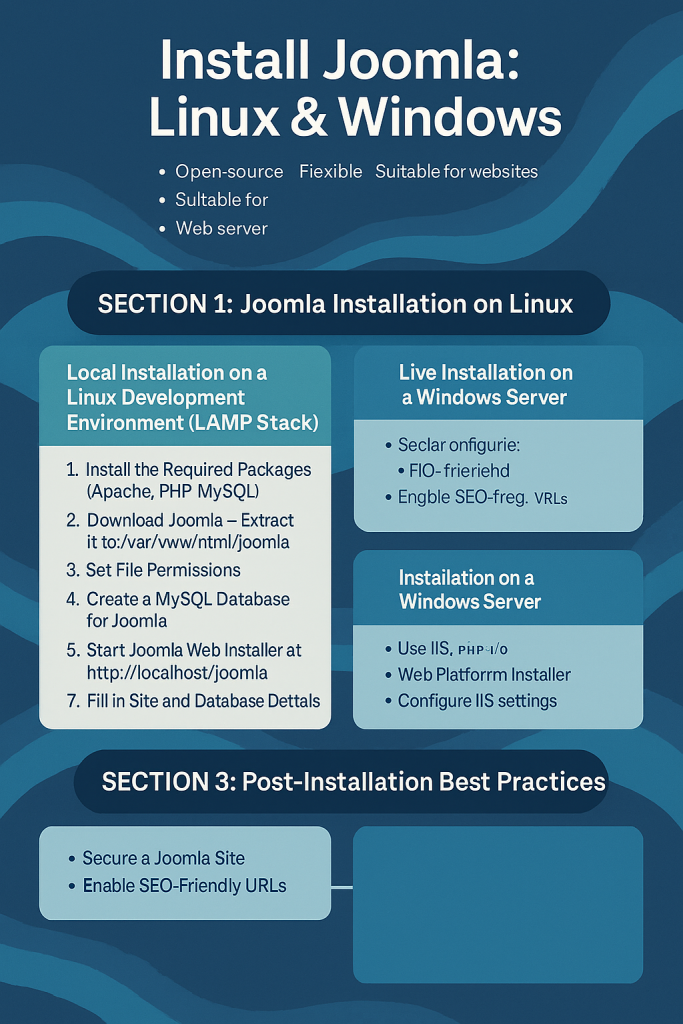Limited Time Offer!
For Less Than the Cost of a Starbucks Coffee, Access All DevOpsSchool Videos on YouTube Unlimitedly.
Master DevOps, SRE, DevSecOps Skills!
What is Joomla and Why Install It?
Joomla is one of the most popular open-source Content Management Systems (CMS). It allows you to build dynamic websites, blogs, e-commerce platforms, and complex web applications without writing code from scratch. It is:
- Free and community-supported.
- Flexible with thousands of templates and extensions.
- Suitable for both beginners and professional developers.
To use Joomla, you need a web server, a database, and PHP. Whether you are on Linux or Windows, the setup process follows the same core logic:
Prepare the server environment.
Download and extract Joomla.
Create a database.
Run the Joomla web installer.
Configure and secure your site.
Joomla Installation on Linux

Linux is the most common platform for Joomla, especially for live servers. We’ll cover both local development (LAMP stack) and live hosting server setup.
A. Local Joomla Installation on Linux (LAMP Stack)
Step 1: Install the Required Packages (Apache, PHP, MySQL)
Linux doesn’t come with web server software pre-installed. We’ll use the LAMP stack.
On Ubuntu/Debian, open the terminal and run:
sudo apt update
sudo apt install apache2 mysql-server php php-mysql php-xml php-mbstring unzip curl -y
- Apache2: The web server that serves your Joomla pages.
- MySQL: Database engine for storing Joomla content.
- PHP: Server-side scripting language that Joomla runs on.
- Extensions:
php-xml,php-mbstringare required by Joomla.
Step 2: Download Joomla
Navigate to a temporary folder:
cd /tmp
wget https://downloads.joomla.org/cms/joomla4/latest/Joomla_4-Stable-Full_Package.zip
Always download from the official Joomla site to avoid tampered packages.
Step 3: Extract Joomla to the Web Root
sudo mkdir /var/www/html/joomla
sudo unzip Joomla_4-Stable-Full_Package.zip -d /var/www/html/joomla
This will place Joomla files in /var/www/html/joomla.
Step 4: Set File Permissions
Correct permissions are critical for Joomla to function and remain secure.
sudo chown -R www-data:www-data /var/www/html/joomla
sudo chmod -R 755 /var/www/html/joomla
www-datais the Apache user on Ubuntu.755allows Joomla to run while preventing unauthorized writes.
Step 5: Create a MySQL Database for Joomla
Log into MySQL:
sudo mysql -u root -p
Create a database and user:
CREATE DATABASE joomla_db;
CREATE USER 'joomla_user'@'localhost' IDENTIFIED BY 'StrongPassword';
GRANT ALL PRIVILEGES ON joomla_db.* TO 'joomla_user'@'localhost';
FLUSH PRIVILEGES;
EXIT;
Replace StrongPassword with a secure password.
Step 6: Start Joomla Web Installer
Open your browser and visit:
http://localhost/joomla
You’ll see the Joomla setup wizard. It will ask for:
- Site Name
- Admin Email
- Admin Username & Password
- Database Details (name, user, password you created)
Click Install to start the process.
Step 7: Remove the Installation Folder
For security, Joomla disables the site until the installation folder is deleted:
sudo rm -rf /var/www/html/joomla/installation
You now have Joomla running locally on Linux.
- Frontend:
http://localhost/joomla - Admin Panel:
http://localhost/joomla/administrator
B. Joomla Installation on a Live Linux Server
The process is similar to the local setup, with a few differences:
- SSH into your server:
ssh username@your_server_ip - Install Apache, MySQL, PHP (same as local).
- Upload Joomla via FTP or
wgetinto/var/www/html/yourdomain. - Create a database in MySQL or via your hosting panel.
- Point your domain DNS to the server IP.
- Run the web installer at
https://yourdomain.com.
Tip: Create an Apache Virtual Host to host multiple Joomla sites on one server.
Joomla Installation on Windows
Windows users usually prefer an easy local setup with XAMPP or WAMP. Joomla can also be deployed on Windows Server using IIS.
A. Local Joomla Installation on Windows (XAMPP)
Step 1: Install XAMPP
- Download XAMPP from https://www.apachefriends.org
- Install it to
C:\xampp. - Open XAMPP Control Panel and start:
- Apache
- MySQL
Step 2: Download Joomla
- Get the Joomla ZIP package.
- Extract it into
C:\xampp\htdocs\joomla.
Step 3: Create a Database
- Go to
http://localhost/phpmyadmin. - Click Databases → Create New Database.
- Name it
joomla_db.
Step 4: Run the Joomla Installer
- Open
http://localhost/joomlain your browser. - Fill in:
- Site Name, Admin Login, Password.
- Database Name:
joomla_db - Database User:
root(default XAMPP user) - Leave password blank (unless you set one).
Step 5: Delete Installation Folder
Go to C:\xampp\htdocs\joomla and delete the installation folder.
Joomla is live locally on Windows:
- Frontend:
http://localhost/joomla - Backend:
http://localhost/joomla/administrator
B. Joomla on Windows Server (IIS)
- Install IIS, PHP, and MySQL (or use Web Platform Installer).
- Extract Joomla to
C:\inetpub\wwwroot\joomla. - Configure IIS to serve PHP pages.
- Create a MySQL database.
- Access
http://yourdomain.comand run the installer.
Post-Installation Best Practices
Secure Your Joomla Site
- Always update to the latest version.
- Set strong admin passwords.
- Use HTTPS.
Enable SEO-Friendly URLs
- Rename
htaccess.txtto.htaccess. - Enable Apache
mod_rewriteor IIS URL Rewrite.
Install Essential Extensions
- Akeeba Backup (for full-site backups)
- Security plugins and caching extensions.
Regular Backups
- Schedule automatic database and file backups.
Final Thoughts
- Linux is the preferred environment for production Joomla sites due to stability.
- Windows (XAMPP/WAMP) is perfect for local development and testing.
- The core process is the same:
Prepare environment → Download Joomla → Create database → Run installer → Secure site.

Leave a Reply